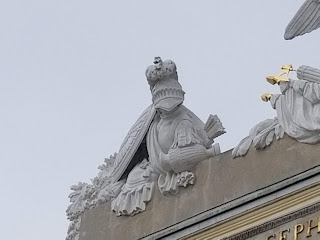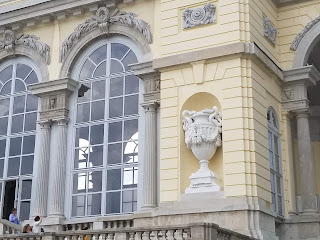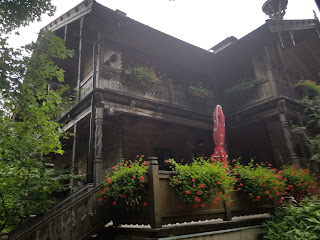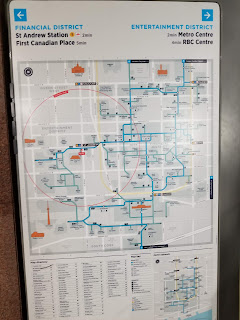Wednesday 9 January 2019
Tuesday 8 January 2019
Schönbrunn Palace and Gardens , Gloriette
The early history of Schönbrunn
The
history of Schönbrunn and the buildings that previously stood on this
site dates back to the Middle Ages. From the beginning of the fourteenth
century, the estate as a whole bore the name of Katterburg and belonged
to the manor of the abbey at Klosterneuburg. The estate boasted a
corn-mill together with an arable farm and vineyards. Over the following
centuries numerous lessees are documented, including a reference in
1548 to one Hermann Bayer, mayor of Vienna, who extended the property,
transforming it into a substantial country estate.
In 1569 the estate came into Habsburg possession through Maximilian II, and according to the title deeds included a house, a watermill and stabling as well as a pleasure garden and an orchard. Maximilian was primarily interested in extending the game park, which was principally intended for the breeding of native game and fowl. However, the pheasantry also contained exotic fowl such as peacocks and turkeys.
Following the sudden death of Maximilian II in 1576 the Katterburg passed to Rudolph II, who did little except sanction the necessary funds for its upkeep. Emperor Matthias used the estate for hunting, and according to a legend is supposed to have come across the Schöner Brunnen (meaning ‘fair spring’), which eventually gave the estate its name, while out hunting in 1612.
In 1569 the estate came into Habsburg possession through Maximilian II, and according to the title deeds included a house, a watermill and stabling as well as a pleasure garden and an orchard. Maximilian was primarily interested in extending the game park, which was principally intended for the breeding of native game and fowl. However, the pheasantry also contained exotic fowl such as peacocks and turkeys.
Following the sudden death of Maximilian II in 1576 the Katterburg passed to Rudolph II, who did little except sanction the necessary funds for its upkeep. Emperor Matthias used the estate for hunting, and according to a legend is supposed to have come across the Schöner Brunnen (meaning ‘fair spring’), which eventually gave the estate its name, while out hunting in 1612.
His successor, Emperor Ferdinand II, and his wife, Eleonora von Gonzaga,
both passionately keen on hunting, chose Schönbrunn as the venue for
their hunting parties. After Ferdinand’s death in 1637 the estate became
the dower residence of his art-loving widow, who needed the appropriate
architectural setting for her busy social life. She therefore had a
château de plaisance built around 1642, which was accompanied by the
renaming of the Katterburg as Schönbrunn, a change of name first documented in the same year.
In 1683 the château de plaisance and its deer park fell victim to the depredations of Turkish troops during the siege of Vienna. From 1686 the estate was in the possession of Emperor Leopold I, who decided that he would make the estate over to his son and heir, Joseph, and have a splendid new residence built for him. Soon afterwards the Rome-trained architect Johann Bernhard Fischer von Erlach arrived at court on the recommendation of aristocratic patrons. In 1688 he presented the emperor with a preliminary set of designs for a new palace, the so-called Schönbrunn I Project, with which he sought to display his architectural abilities and gain the emperor’s interest. Fischer was promptly engaged as tutor for architecture to the heir to the throne in 1689 and subsequently enjoyed a brilliantly successful career as architect to the court and nobility.
In 1683 the château de plaisance and its deer park fell victim to the depredations of Turkish troops during the siege of Vienna. From 1686 the estate was in the possession of Emperor Leopold I, who decided that he would make the estate over to his son and heir, Joseph, and have a splendid new residence built for him. Soon afterwards the Rome-trained architect Johann Bernhard Fischer von Erlach arrived at court on the recommendation of aristocratic patrons. In 1688 he presented the emperor with a preliminary set of designs for a new palace, the so-called Schönbrunn I Project, with which he sought to display his architectural abilities and gain the emperor’s interest. Fischer was promptly engaged as tutor for architecture to the heir to the throne in 1689 and subsequently enjoyed a brilliantly successful career as architect to the court and nobility.
At the end of the seventeenth century Emperor Leopold I commissioned the Baroque architect Johann Bernhard Fischer von Erlach, who had received his training in Rome, to design an imperial hunting lodge for his son, Crown Prince Joseph, later to become Emperor Joseph I. Replacing the château de plaisance built on this site for the dowager empress Eleonora of Gonzaga in 1642, it was to grow into a palatial imperial residence over the course of the eighteenth century.
The Park and Gardens
In
1569 it passed into imperial possession through Emperor Maximilian II.
The Roman-German emperor was mainly interested in laying out pleasure
gardens and a game preserve in order to indulge his twin passions for
collecting and hunting, the latter a passion which was shared by many
other members of the Habsburg dynasty. The gardens created by Maximilian
were thus not only intended for the keeping of native game and fowl but
also provided space for exotic birds such as peacocks and turkeys, a
standard feature in princely gardens of the time.
After the enclosed gardens of the Katterburg were destroyed by Hungarian forces in 1605, the damage was provisionally repaired and the estate was subsequently only used by Emperor Matthias for hunting.
According to a legend, it was on one of these hunting excursions in 1612 that Matthias discovered the ‘fair spring’ (schöner Brunnen) that was later to give the estate the name by which it would be known. Matthias’s successor, Ferdinand II and his wife Eleonora of Gonzaga, both passionately fond of hunting, also used the park for their hunting parties. Following Ferdinand’s death in 1637 it became the empress’s dower residence and a splendid château de plaisance was built, known from then on as Schönbrunn, a name first documented in 1642.
After the enclosed gardens of the Katterburg were destroyed by Hungarian forces in 1605, the damage was provisionally repaired and the estate was subsequently only used by Emperor Matthias for hunting.
According to a legend, it was on one of these hunting excursions in 1612 that Matthias discovered the ‘fair spring’ (schöner Brunnen) that was later to give the estate the name by which it would be known. Matthias’s successor, Ferdinand II and his wife Eleonora of Gonzaga, both passionately fond of hunting, also used the park for their hunting parties. Following Ferdinand’s death in 1637 it became the empress’s dower residence and a splendid château de plaisance was built, known from then on as Schönbrunn, a name first documented in 1642.
Eleonora
of Gonzaga, who had a rare understanding of art, had magnificent formal
gardens laid out around the palace which became the setting for
frequent court celebrations and festivities. Her niece and successor,
another Eleonora of Gonzaga, widow of Emperor Ferdinand III and like her
aunt a keen patron of the arts, continued to extend the gardens. In the
mid-seventeenth century numerous open-air performances took place in
the ‘famose parco di Scheenbrunn’, occasions on which Emperor
Leopold I displayed his artistic talents as composer and actor. This glittering lifestyle came to an abrupt end when Vienna was besieged by Ottoman forces in 1683, and the palace and park at Schönbrunn were devastated.
Leopold I displayed his artistic talents as composer and actor. This glittering lifestyle came to an abrupt end when Vienna was besieged by Ottoman forces in 1683, and the palace and park at Schönbrunn were devastated.
Links
https://www.schoenbrunn.at/en/about-schoenbrunn/the-palace/history/
https://www.schoenbrunn.at/en/about-schoenbrunn/gardens/history/
https://artsandculture.google.com/partner/schloss-schoenbrunn
Monday 7 January 2019
Toronto PATH- 28 km of Underground Walking Walkways
The name of Toronto has a history distinct from that of the city itself. Originally, the term "Taronto" referred to a channel of water between Lake Simcoe and Lake Couchiching on maps as early as 1675but in time the name passed southward, and was eventually applied to a new fort at the mouth of the Humber River. Fort Toronto was the first settlement in the area, and lent its name to what became the city of Toronto.Fort Rouillé and Fort Toronto were French trading posts located in Toronto, Ontario, Canada. Fort Rouillé was named for Antoine Louis Rouillé, who at the time of its establishment around 1750 was Secretary of State for the Navy in the administration of Louis XV. It served as a trading post with the local indigenous peoples.
The PATH is a mostly underground pedestrian walkway network in
downtown Toronto that spans more than 30 kilometres of restaurants,
shopping, services and entertainment.The walkway facilitates pedestrian linkages to public transit,
accommodating more than 200,000 business-day commuters as well as
tourists and residents. The PATH provides an important contribution to
the economic viability of the city’s downtown core.According to the official history.
"The first underground path in Toronto originated in 1900 when the T
Eaton Co. joined its main store at 178 Yonge St. and its bargain annex
by tunnels. By 1917 there were five tunnels in the downtown core. With
the opening of Union Station in 1927, an underground tunnel was built to
connect it to the Royal York Hotel (now known as the Fairmont Royal
York). The real growth of PATH began in the 1970s when a tunnel was
built to connect the Richmond-Adelaide and Sheraton Centres.
In 1987, City Council adopted the recommendation that the City
become the co-ordinating agency of PATH and pay for the system-wide
costs of designing a signage program.
In 1988, design firms Gottschalk, Ash International, and Keith
Muller Ltd. were retained in by the City of Toronto to apply the design
concept for PATH.
PATH’s name and logo are registered to the City of Toronto. The City
co-ordinates and facilitates the directional signage, maps and identity
markers throughout the system.
Urban Legends
The downtown PATH system: The climate-controlled underground walkways and shopping. But what if we told you that Toronto has another buried city, also populated by pale wizened troglodytes who rarely emerge to see the light of day?
Urban Legends
One of the stranger stories to come out of Toronto has to do with something that supposedly took place in August 1978. Sometime during that month, according to the tale, a Torontonian searching for a lost cat ventured into a tunnel and encountered something terrifying.
The person who went searching for the missing cat on that hot summer day was a 51-year-old man only identified only as “Ernest.” Flashlight in hand, he crawled into a small opening near his apartment building on Parliament Street and found himself in a low tunnel. Here, the story gets strange.
As reported by the Toronto Sun in March 1979, about ten feet into the tunnel Ernest spotted a thin human-like figure some three feet tall, with grey fur and slanted, orange-red eyes. The creature looked at him and hissed the words, “Get out, get out,” before fleeing down a side tunnel.
Ernest, not surprisingly, took off in the direction from which he’d come. So what did Ernest see? It’s possible he was drunk or hallucinating or lying, although the way the article is written seems to suggest that Lorrie Goldstein, the reporter who interviewed him, didn’t think so
There is a small opening to the underground tunnels off Parliament Street in downtown Toronto. (The entrance is between two apartment buildings, and leads to the tunnels via the sewers.) The underground city (abandoned?) beneath Toronto has its center beneath Gerrard Street and Church Street. Above this area, strange magnetic effects have been observed.
(Note: This corner of Gerrard & Church streets has a higher accident rate than anywhere else in Toronto. It is believed that underground equipment utilizing powerful magnetic fields (which have caused many strange magnetic effects in houses near this intersection) are responsible for the bizarre equipment failures that often are the cause of these accidents.
Official Story
In the early 1990s, signage for PATH was developed to provide
pedestrians with better ease of use and functionality. The signage
enhances PATH’s visibility and identity, ultimately increasing its use,
attracting more people to downtown Toronto, and drawing more businesses
there.
In 2016-2017, the City of Toronto and Toronto Financial District BIA
hired Steer Davies Gleave to develop a new PATH Wayfinding system.
Extensive public consultations, conversations with property managers and
review by the PATH Partnership Group resulted in the new PATH
wayfinding installed throughout the PATH in spring 2018."
Facts
With 3.7 million square feet of retail space, there are 1,200
restaurants, shops and services in the PATH, generating roughly $1.7
billion in sales annually. An estimated 4,600 jobs are located in the
PATH. The PATH generates approximately $271 million in federal,
provincial, and municipal tax revenue annually.
More than 75 buildings are connected to the PATH. Six subway
stations, three major department stores, nine hotels, and Toronto’s
busiest transit hub – Union Station – are accessible through the PATH.
The PATH provides links to some of Toronto’s most popular tourist and
entertainment attractions, including the Hockey Hall of Fame, Roy
Thomson Hall, the Air Canada Centre and CF Toronto Eaton Centre. City
Hall and Metro Hall are also connected through the PATH.
Each segment of the walkway system is owned and controlled by the
owner of the property through which it runs. There are about 35
corporations involved.
It is possible to walk through the PATH from the waterfront to
Downtown Yonge, and from the Entertainment District to Yonge St. all of
which connect through Toronto’s world class Financial District.
The PATH is a mostly underground pedestrian walkway network in
downtown Toronto that spans more than 30 kilometres of restaurants,
shopping, services and entertainment.The walkway facilitates pedestrian linkages to public transit,
accommodating more than 200,000 business-day commuters as well as
tourists and residents. The PATH provides an important contribution to
the economic viability of the city’s downtown core.According to the official history.
"The first underground path in Toronto originated in 1900 when the T
Eaton Co. joined its main store at 178 Yonge St. and its bargain annex
by tunnels. By 1917 there were five tunnels in the downtown core. With
the opening of Union Station in 1927, an underground tunnel was built to
connect it to the Royal York Hotel (now known as the Fairmont Royal
York). The real growth of PATH began in the 1970s when a tunnel was
built to connect the Richmond-Adelaide and Sheraton Centres.
In 1987, City Council adopted the recommendation that the City
become the co-ordinating agency of PATH and pay for the system-wide
costs of designing a signage program.
In 1988, design firms Gottschalk, Ash International, and Keith
Muller Ltd. were retained in by the City of Toronto to apply the design
concept for PATH.
PATH’s name and logo are registered to the City of Toronto. The City
co-ordinates and facilitates the directional signage, maps and identity
markers throughout the system.
Urban Legends
The downtown PATH system: The climate-controlled underground walkways and shopping. But what if we told you that Toronto has another buried city, also populated by pale wizened troglodytes who rarely emerge to see the light of day?
Urban Legends
One of the stranger stories to come out of Toronto has to do with something that supposedly took place in August 1978. Sometime during that month, according to the tale, a Torontonian searching for a lost cat ventured into a tunnel and encountered something terrifying.
The person who went searching for the missing cat on that hot summer day was a 51-year-old man only identified only as “Ernest.” Flashlight in hand, he crawled into a small opening near his apartment building on Parliament Street and found himself in a low tunnel. Here, the story gets strange.
As reported by the Toronto Sun in March 1979, about ten feet into the tunnel Ernest spotted a thin human-like figure some three feet tall, with grey fur and slanted, orange-red eyes. The creature looked at him and hissed the words, “Get out, get out,” before fleeing down a side tunnel.
Ernest, not surprisingly, took off in the direction from which he’d come. So what did Ernest see? It’s possible he was drunk or hallucinating or lying, although the way the article is written seems to suggest that Lorrie Goldstein, the reporter who interviewed him, didn’t think so
There is a small opening to the underground tunnels off Parliament Street in downtown Toronto. (The entrance is between two apartment buildings, and leads to the tunnels via the sewers.) The underground city (abandoned?) beneath Toronto has its center beneath Gerrard Street and Church Street. Above this area, strange magnetic effects have been observed.
(Note: This corner of Gerrard & Church streets has a higher accident rate than anywhere else in Toronto. It is believed that underground equipment utilizing powerful magnetic fields (which have caused many strange magnetic effects in houses near this intersection) are responsible for the bizarre equipment failures that often are the cause of these accidents.
Official Story
In the early 1990s, signage for PATH was developed to provide
pedestrians with better ease of use and functionality. The signage
enhances PATH’s visibility and identity, ultimately increasing its use,
attracting more people to downtown Toronto, and drawing more businesses
there.
In 2016-2017, the City of Toronto and Toronto Financial District BIA
hired Steer Davies Gleave to develop a new PATH Wayfinding system.
Extensive public consultations, conversations with property managers and
review by the PATH Partnership Group resulted in the new PATH
wayfinding installed throughout the PATH in spring 2018."
Facts
restaurants, shops and services in the PATH, generating roughly $1.7
billion in sales annually. An estimated 4,600 jobs are located in the
PATH. The PATH generates approximately $271 million in federal,
provincial, and municipal tax revenue annually.
stations, three major department stores, nine hotels, and Toronto’s
busiest transit hub – Union Station – are accessible through the PATH.
The PATH provides links to some of Toronto’s most popular tourist and
entertainment attractions, including the Hockey Hall of Fame, Roy
Thomson Hall, the Air Canada Centre and CF Toronto Eaton Centre. City
Hall and Metro Hall are also connected through the PATH.
owner of the property through which it runs. There are about 35
corporations involved.
Downtown Yonge, and from the Entertainment District to Yonge St. all of
which connect through Toronto’s world class Financial District.
Subscribe to:
Posts (Atom)
The Mysterious Vatican
Resonate design columns display a low frequency rate at the tops of the columns and transitions to a high frequency design at bottoms. At th...
-
We Should ask why this concerted effort to destroy old buildings and old architecture of this city? Who are the ...
-
An important part of New York City’s African-American heritage lies hidden in Central Park’s murky pre-history. Although it’s difficult to...























































































